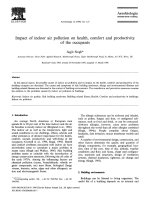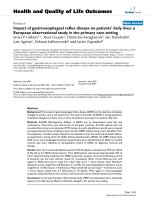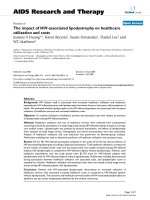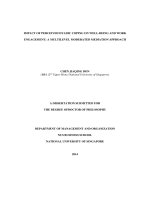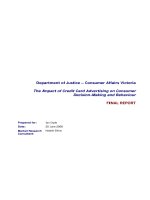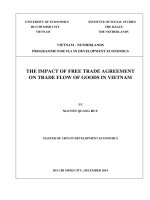Impact of world trade organization on demand pattern and opportunities to tea farmers in Nepal
Bạn đang xem bản rút gọn của tài liệu. Xem và tải ngay bản đầy đủ của tài liệu tại đây (224.69 KB, 16 trang )
IMPACT OF WORLD TRADE ORGANIZATION
ON DEMAND PATTERN AND OPPORTUNITIES
TO TEA FARMERS IN NEPAL
Keshav Bhakta Sapkota*
ABSTRACT
Nepal became member of WTO after it adopted open market and
economic liberalization policy. Obviously, this kind of membership to
WTO could have some kind of implications on Nepalese market. This
article is based on the empirical data generated through intensive field
work. This article reveals that after Nepal became member of WTO it has
direct impact on the demand pattern of Nepalese market. But there is no
influence in the creation of new employment opportunities. However,
farmers have got different opportunities of getting trainings and access to
formal and informal education. More importantly, access to WTO has
transformed tea farming from subsistence to commercial and thus
increasing the demand of Nepalese tea in international market.
Key Words: WTO, demand, employment, Nepal
WORLD TRADE ORGANIZATION (WTO)
The WTO is an international body which deals with the
international trade rules. As a successor to the General Agreement on
Trade and Tariff (GATT), the WTO was established in January 1995 with
the principle as "to provide the common institutional framework for
conducting trade relations among its members in matters related to the
agreement" (Article II Marrakesh agreement).
Nepal applied for the membership of GATT, (the predecessor of
the WTO), in 1989. However, the efforts for obtaining membership of the
GATT could not be materialized due to the long accession process. Nepal
has eventually become the 147th member of the global trade regime. The
fifth ministerial meeting of the WTO held in September 10-14, 2003 in
Cancun, Mexico decided to provide the membership of WTO to Nepal.
As Nepal had the experience of initiating the economic liberalization
program during mid 1980s and fullfledgelly in early 1990, the WTO
accession was not a surprising phenomenon for Nepal.
On 23 April 2004, Nepal has formally been inducted in the WTO
as its 147th member. Although there were various groups of opponents
who were against the agreement, Nepal's newly acquired membership in
the WTO marks the beginning of the expansion of Nepal's international
*
Dr. Sapkota is Reader in Economics at Birendra Multiple Campus, Tribhuvan University,
Bharatpur , Nepal.
74
IMPACT OF WORLD TRADE ...
trade integration with global market. It is believed that the WTO brings
both opportunities and challenges to poor country like Nepal.
WTO
AGREEMENTS
AND
ITS
IMPLICATION
ON
AGRICULTURE
Young and Westcott (1998) report that crop insurance subsidies
averaged US Dollar 1.4 billion during 1995-98, resulting in an increase of
600000 hectares planted, with wheat and cotton showing the largest
percentage gains. Beginning in 2001, U.S. crop insurance subsidy almost
double to about U.S. Dollar 3.0 billion owing to the reform by Congress to
improve the “safety net” for U.S. farmers (2000: 762-67).
Ministry of Industry, Commerce and Supply (MOICS) and
Government of Nepal had their own estimates for SPS and TBT
respectively. MOICS, on the one hand, has submitted a report to WTO
with a detail action plan for implementing the SPS measures at the time
of accession to the WTO. The action plan estimates that it will cost US$
12.5 million to introduce an improved Sanitary and Phyto Sanitary (SPS)
regime. While the government, on the other, estimates that it needs US$
12 million over a five year period to comply with the agreement on
Technical Barriers to Trade (TBT). This would cover procuring
equipment purchasing consulting services. Similarly, it is estimated that
it will cost between US$ 4 million to US$ 32 million to fully implement
Intellectual Property Right (IPR) law in Nepal. These cost are more than
the entire annual budget of many LDCs like Nepal. So, the
implementation of WTO rules, agreements and obligations are more
problematic for Least Developed Countries (LDCs) (MoICS, 2003).
In this connection, Thapa (2004) in his study, fitted equations for
exports and other variables (e.g. time) as follows (t indicates time or
years): Tea export= 4.5+7.4t; Tea import=818-25t: Unit export price=
1287+136t; and Unit import price = 2161-11t. But this study did not
establish the relationship between the land holding size and productivity
as well as education status of the farmers and their productivity.
Similarly, Awasthi and Adhikari, (2004: 35) in their article,
analyzed various provisions of domestic supports measures of Agreement
on Agriculture (AoA). Furthermore, their study states about some
implications of AoA on Nepalese agriculture sector. It was noted that the
AoA disciplines or limits only some forms of subsidies that were
production and trade distorting. Thus, there are no supports limits on
Green Box measures like agricultural research, extension, agricultural
roads etc. Hence, there were no issues here from the WTO standpoint as
regards non- exempt support measures that fall under the Amber Box
category, express in terms of aggregate measurement of support (AMS),
Nepal committed at the time of the WTO Accession to limit these
TRIBHUVAN UNIVERSITY JOURNAL, VOLUME. XXX, NUMBER 2, DECEMBER 2016
75
subsidies to within the de minimis level, or 10 percent of the Value of the
Agriculture Output (VoAP).
They further state that Nepal did not have product –specific AMS
as there were no price supports programmers. The study had further added
that AoA does not prohibit these programmes for the future provided that
the subsidies are limited to the diminimis level. In any case, the amount of
subsidies permitted in considerable as regards non product specific AMS
(e.g. on fertilizer, irrigations, seeds, credit etc), Nepal can grant these
subsidies any time up to the deminimis level. Compare with this limit of
10 percent of the VoAP. In fact, even if the entire government budget on
agriculture is assumed to be subsidies, the ratio does not exceed 5 percent.
So, the study concludes, as regards the implication of AOA on agriculture
sector is that this agreement provides ample room for Nepal to supports its
agriculture. The main constraint is resource, not the AoA (ibid).
Chitrakar and Thapa (2004:34-35) in their book, argued that standard
related agreement of WTO should be applied by all member countries. But
for the LDCs, like Nepal, it is not easy to implement the standard related
agreement namely, SPS measures and TBT agreement in various ground.
Additionally, they argued and indicated that even the relatively industrialized
countries such as China, Argentina and Russia needed US$ 82.7 million, US$
10 million, and US$ 150 million respectively for implementation of some
SPS measures. This accounts for more than the development budget of seven
of the twelve LDCs for which no figures had been calculated as
implementation costs yet. It implied that the agreements place a much
heavier burden of compliance to LDCs most standard were favorable for high
technology and capital rich companies and a country like Nepal’s Labour
incentives manufacturing industry companies cannot take benefit much from
the agreements as much. Meanwhile, the cost of the SPS and TBT measures
especially in agriculture is very high and the technical assistance to be
provided by developed countries is not binding.
CHANGES IN DEMAND PATTERN OF GREEN LEAVES AFTER
THE ACCESSION TO WTO
Market nature and contact with international market have direct
bearing on demand pattern. International trade organizations influence the
demand pattern. WTO is one of the organizations that influences demand
pattern. The condition in demand pattern of green leaves according to the
tea farmers are presented in the following table.
76
IMPACT OF WORLD TRADE ...
Table-1: Changes in Demand Pattern of Green Leaves after the
Accession in WTO
Condition of Change
Changing noticed
No changing
Little change
Number Percentage Responses
Percent
5
25
8
3.1
15.4
4.9
13.2
65.8
21.1
38
23.5
100
No answered
124
76.5
Total:
162
100
Source: Field Survey, 2008.
Table 1 exhibit that 124 out of 162 respondents did not answer
any thing. Just 23.5 percent respondents answered the question. Out of
total respondents, 65.8 percent respondents were found that they did not
notice any change in demand pattern of green leaf after the accession to
WTO. Similarly, 13.2 percent out of 38 respondents noticed change in
demand pattern of green leaf after the entry into the WTO. Next 21.1
percent out of 38 respondents felt a slightly change in demand pattern.
Out of 13, 53.8 percent respondents said that organically produced
green leaf was in bigger demand than the others. 30.79 percent tea farmers
said that farmers who are engaged in the tea cultivation were motivated to
produce green leaf under the Code of Conduct (CoC) of Himanalyan
Orthodox Tea Planters Association (HOTPA). According to 15.38 percent
respondent expressed that Minimum Residue Level (MRL) applied green leaf
was more demanded. It indicates that very few farmers were aware about the
WTO impact on green leaf demand. Most of them focused on organic green
leaf as it was highly demanded. It can be concluded here that, if we want to
participate in world market, production method of green leaf should be
organic. This is an implication of WTO on green leaf production and more
demanding pattern of organically produced green leaf.
EMPLOYMENT CREATION IN TEA SECTOR OF NEPAL
Nepal has a pre-dominantly rural population similar to other
Asian neighbors. About 30,000 family units and more than 40,000 labour
forces, with a majority of the workforce being women, were involved in
the sector (ITC, 2007). Both the total area and production of tea in Nepal
have increased tremendously over the last few years. So, in the tea sector,
employment opportunities have also been increasing.
TRIBHUVAN UNIVERSITY JOURNAL, VOLUME. XXX, NUMBER 2, DECEMBER 2016
77
Similarly, respondents were asked whether the impact of WTO on
employment creation was positive or negative. Their responses are
presented in Table-2.
Table-2: Impact of WTO on Employment Creation
Impact
Experiences
Positive Impact
Negative Impact
No Change at all
Total
No Response
Total:
Number
Percentage
48
3
70
29.63
1.85
43.21
121
41
Responses
Percent
39.67
2.48
57.85
100.00
25.31
162
Source: Field Survey, 2008.
Table-2 shows that 39.67 percent out of 121 respondents said that
after Nepal’s accession in WTO, its impact on tea sector employment creation
has been positive. Likewise 2.48 percent respondents said its impact on tea
sector was negative and 57.85 percent respondents said there was no change
at all in employment creation after the accession in WTO of Nepal.
Those respondents who answered as positive impact of WTO on
tea sector mainly due to the extension of their farm size and at the same
time some tea planters were adding the technical manpower for good
agricultural practices which created some new jobs on the tea sector.
Three respondents out of one hundred sixty two were found to be argued
that impact of WTO on employment creation is negative. Mainly, due to
the decline pattern of green leaves price tea planter/farmers were not
devoted on tea garden management in a good manner. Result of this
situation was negative on tea sector employment. A total of 70
respondents out of 162 found their experiences of WTO impact on
employment as having no change at all. According to them, decreasing
price and increasing cost of production was the main cause of constant
level of employment. As a result, farmers were not encouraged to
extension of their farm size, although there is potentiality of extension.
However they had additional land to plantation of tea. Therefore,
employment on tea sector was not changed. Thus, it can concluded that
job creation on tea sector is possible if green leaf price trend is up warded
78
IMPACT OF WORLD TRADE ...
or reasonable price gets according to their cost of production will be paid
to the farmers.
Figure-1
Source: Field Survey, 2008.
Figure-1 shows the impact of WTO on employment creation.
Most of the participants of focus group discussion argued that after the
WTO membership too there was no new opportunity for employment.
KNOWLEDGE ABOUT THE WTO AGREEMENT
Agreement on Agriculture (AoA), Sanitary Phyto Sanitary (SPS)
measures, Technical Barriers on Trade (TBT) and Trade Related Intellectual
Property Rights (TRIPs) are more concerned agreements of WTO for
Nepalese agriculture. In this regard, to find out whether these agreements
were affecting or not in tea farming of Nepal and at the same time, what was
the understanding level of the tea planters/farmers on the above mentioned
agreement, was the concerning aspect of this study. The following table
presents the responses of the respondents on WTO agreement:
Table-3: Knowledge about the WTO Agreement
Understanding
Position
Number
Percent
Known
19
11.70
1.
Unknown
143
88.30
2.
Total:
162
100.00
Source: Field Survey, 2008.
S.N.
Known Respondents
Application
of WTO
No Percent
Agreement
Tea plantation 15
78.9
with MRL
application
SPS
4
21.1
measures/food
safety
measures
TRIBHUVAN UNIVERSITY JOURNAL, VOLUME. XXX, NUMBER 2, DECEMBER 2016
79
Table-3 depicts that 19 out of 162 respondents were found to have
said that they were familiar about the WTO agreement like, AoA, SPS and
others. Those who belonged to higher education status were simply literate
about the WTO and its agreements. Majority of the farmers were not able to
understand the WTO and its agreements. Out of 162 respondents 88.3 percent
said that they were uninformed about the WTO and its agreements.
Among the selected respondents, 78.9 percent were found to have
been following the WTO and its agreements as MRL implementation in tea
cultivation. It indicates that use of pesticide/insecticide should be at minimum
level as prescribed. The tea farmers mainly belonged to Ilam district, were
found to have decreasing tendency in application of chemical fertilizer and
pesticide/insecticide. These farmers were inclined towards the organic tea
farming which had more demand in world market especially in the developed
world. 21.1 percent respondents said that for the implementation of sanitary
and Phyto-Sanitary (SPS) measures of WTO, they were conscious about the
food product which should be safe for human consumption.
Figure- 2
Source: Field Survey, 2008.
Figure-2 shows the knowledge about the WTO. According to the
figure, 16.7% respondents knew what WTO was and what it did and 25%
repondents were unfamiliar with this while 58.3% respontets had little
knowledge of WTO.
PRESENT CONDITION AND SUPPORT NEEDED
TRANSPORTATION CONDITION AND COST
Transportation is the most important infrastructure to develop the
tea sector. But most of the green leaf farmers are located in areas, where
infrastructure is poor. Although, they are able to produce the leaves in
quantities, method of transportation, such as an animal back, bicycles
80
IMPACT OF WORLD TRADE ...
which are unsatisfactory because of they cause damage to the leaves in
transit. Access to the farmer's premises quickly with suitable vehicles
should be made available. After the plucking of green leaf, generally, with
base of quality concern it should be brought at the factory premises within
3 hours. So, the transportation facility and means of transportation is vital
concern in quality aspect of tea. Data on road condition, distance, means
and cost of transportation is given in following Table-4.
Table-4: Road Condition, Distance, Means and Cost of Production
Kg/Rs.
%
No
%
2
2.9
>2 Rs.
18.9
%
No
No
58
14
%
>1 <2
78
No
56
<1
Rs.
38.1
%
23.1
%
42.1
%
%
No
64
No
34
22.4
Cost Transportation
FareWeathe
No
%
Grave
led
34
No
39
25.7
Black
Toped
No
%
Man
57
No
Road Condition
Tract
or,
Jeep,
Truck
38.8
Hor
se
15
%
22.0
Riksha
Van
9.9
%
No
33
No
61
%
Means of Transportation
40.7
No
56
37.3
Distance
Km from Green Leaf
Production Area to the
Market
<3
>3 <6
>6
Source: Field Survey, 2008.
Road condition has been classified into three categories. They are
black topped, graveled and fair weather. Black topped, graveled and fair
weather road are 38.8, 23.1 and 38.1 percent respectively. It indicates that
nearly about two-third part of the road is not well. Low grade road
increases the cost of transportation and length of delivery of green leaf
into the factory premises and quality green leaf can deteriorate.
Cost of transportation of green leaves in the study area is classified
into the three groups. One is the category of less than Re 1/kg. Within this
group 78.4 percent respondents were found. Second classification was 1 2
Rs/kg and third was 2 Rs/kg. 18.9 and 2.9 percent respondents were found as
second and third classification respectively.
CREDIT FACILITY/TAKEN FROM
Proper investment is needed to the development of the tea sector.
For it financial position of tea planter should be managed in whatever the
way, may be possible either from bank/financial institutions or by himself.
Tea planting in Nepal is small and mainly small land holder's are engaged
in this sector. So, there is no need of large amount credit. However, small
amount is needed to start tea cultivation and maintain the gardens. Tea
cultivation has been financed largely from the resources of the households
themselves. Everyone hasn't taken loan, and even those who have
borrowed loan from the bank, have not been always and exclusively using
the fund for meeting expenditure related to tea plantation. Tea farmers
would like to take loan from the bank only because of the low interest rate
81
TRIBHUVAN UNIVERSITY JOURNAL, VOLUME. XXX, NUMBER 2, DECEMBER 2016
than that of local money lenders. But taking loan from Bank has not been
attractive because of the difficulties in the process and prompt sanction.
Several households felt that there was need of soft loan for expansion of
tea cultivation. They also express that the loan taking process should be
simple. However, field data exhibit that out of 162 respondents 64.8
percent respondents had taken loan from the different sources, which is
shown in Table-5.
Table-5: Sources of Credit Acquisition
Sources
Commercial Bank
Number
Percentage
Responded
Percentage
6
3.7
5.0
72
44.4
59.5
4
2.5
3.3
Co-operatives
23
14.2
19.2
Local Money
Lender
16
9.9
13.2
No Response
41
25.3
162
100.00
ADB/N
Financial/Institution
Total:
100
Source: Field Survey, 2008.
It is obvious that amongst the respondents 59.5 percent farmers
took loan from the Agricultural Development Bank of Nepal (ADB/N)
followed by co-operatives and local money lender. Very few farmers took
credit from commercial banks and financial institutions. Data indicate that
ADB/N is a major source of credit for the tea planter. Co-operative
organizations and local money lender were 2nd and 3rd sources of credit for
the tea planter in study area. But 41 respondents out of 162 did not
response about any sources of credit. It means that they were managing
financial aspect by themselves.
AUCTION MARKET
Nepal has a dual manufacturing base. It produces Cut, tear and
curl (CTC) and Orthodox type of tea. Nepal's tea production is minimal in
comparison to global market. The volume of production is 0.48 percent
and currently exported volume is around 0.56 percent, out of total global
output (ITC, 2010). So, establishment of global auction market in Nepal
has low potentiality.
82
IMPACT OF WORLD TRADE ...
Auction market is necessary factor for giving encouragement to
the production/distribution of tea. Roughly 70 percent of global tea
production is traded at auction (ITC, 2007). The rest is effectuated through
private sales. Nowadays, the main centers are in India (Kolkata and
Kochi), Sri Lanka (Colombo) and Kenya (Mombassa). The latter is also
the auction centre for many other African tea producing countries. Some
other important tea-producing countries, such as China, Argentina and
Turkey, do not have an auction system. However for Nepal, according to
field report data 142 out of 162 respondents said that auction market was
necessary factor for tea trade. Transparency of price, knowledge about the
international tea market and price according to quality and grade were the
main benefits of auction market. 58.6 percent respondents answered as
price fixation and transparencies in price fixing were the benefit of
auction. So, it is needed in Nepal as well.
Although all of 12 respondents, from tea processing factories,
both CTC and Orthodox type tea producers, felt need of auction market.
But one respondent from CTC type said that Nepal's production of tea was
very limited in quantity so its establishment and good operation was very
difficult. According to him it can be run with full cooperation and support
from the government.
Almost all the respondents from exporters said that auction
market was necessary to enhance the tea market. According to the
respondents who were surveyed regarding the issue of auction market said
that it was beneficial for the price fixation according to quality/grade,
price transparency, communication with local buyers and price
competition. This fact was further proved by the participants of focus
group discussion as well.
INFORMATION ACCESS ON INTERNATIONAL MARKET
Tea is a processed agricultural product, which is traded in the
world market. For this reason, it is better to highlight about the overall
situation of tea globally, like production and consumption situation, tea
producing countries, prices of leave and readymade tea, auction market
etc. not only for tea processing factory and exporters but also for tea
farmers. International tea market information accesses through different
media are shown in following table 6. Field report data show that 72.8
percent tea planters were found to have no access to international market.
25.3 percent out of 162 respondents were found to have access of
information about international tea market through Radio, TV, Newspaper
TRIBHUVAN UNIVERSITY JOURNAL, VOLUME. XXX, NUMBER 2, DECEMBER 2016
83
but just 1.9 percent respondents have access information through personal
link by Telephone and Internet.
Table-6: International Tea Market Information Access through Different
Media
Media Access
Number
Percent
Radio, TV, Newspaper
41
25.3
Telephone/Internet
3
1.9
118
72.8
162
100.00
No media access
Total:
Source: Field Survey, 2008.
CHANGING OF DEMAND PATTERN OF NEPALESE TEA IN
INTERNATIONAL MARKET
Demand pattern of Nepalese tea in international market has been
changed for the last 10 years. This situation was experienced by the
respondents. All of the five respondents (exporters) felt that there was
change in demand pattern at the international market. Among the five
exporters one said that there was no organic certification, as a result,
European market has been down. Similarly, three out of five said that
there was change in demand pattern due to the beginning of fair trade and
participation in such occasion. As a result, publicity, quality improvement,
specialty produce type of tea was highly demanded in international
market. Mainly, respondents focused on organic and quality certification,
fair trade and specialty production of tea to grab the global demand of tea.
EFFECTS OF CHEAP IMPORTED PRODUCT ON EXPORT
According to the field data, all the five respondents said there was
no cheap import of tea, but there was existence of quality import. So, due
to this reason there was not an important question about cheap imports of
tea and its effect on tea.
They were not damaging the profession by cheap import
according to all five exporters. But among the respondents, one said that
import of tea did not damage the profession but there is effect on export of
Nepalese tea, as making less price, less demand, has reduced income and
reducing the capacity.
IMPACT OF WTO ON EXPORT/EXPORTERS OF TEA
In this study exporters were asked what they experienced on tea
export after the accession of Nepal into the WTO? Their responses
presented in table 7.
84
IMPACT OF WORLD TRADE ...
Table-7: Experiences of Exporters, After Entering in to the WTO
Experiences
Ranking
5
4
3
2
1
Harmful
-
-
-
3
2
Beneficial
2
3
-
-
-
More competitive
2
1
2
-
-
Need to improve quality
5
-
-
-
-
Market damaging
-
-
-
1
4
Source: Field Survey, 2008.
According to Table, tea exporters had found it beneficial to export
tea after entering of Nepal into the WTO. Out of 5 respondents 2 and 3
gave highest scale 5 and 4 respectively for the beneficial experiences. Due
to the market access opportunity of WTO agreement exporters could grab
the opportunity as per the response of respondents.
All the respondents said there was need to improve quality of tea
to take the global market. They gave the highest rank to improve quality.
According to their preference, without quality or competitive product the
space in global market would not be occupied. Tea exporters had
experienced that global market would be more competitive after the entry
into the WTO. Out of 5 exporters 2 rated highest rank for market would be
more competitive. One and 2 respondents respectively rated 2nd and 3rd
option for market is being more competitive.
After the entry into WTO, exporting condition of tea is not
harmful and market damaging condition may not occur as per the response
of the respondents because they did not focus on it. Most of the
respondents rated lowest scale for this condition which would not be
harmful and market damaging after entering into the WTO. Consumers of
developed countries are more conscious about the quality/organic product.
According to them, if Nepal's product was qualitative and organic, export
potentiality of Nepalese tea would be high in international market.
EXPORT AND POLICY RELATED INFORMATION ON TEA
EXPORTERS
FACTORS FOR BETTER EXPORT
Different factors are responsible for the export of tea. If a country
can export large quantity of product with high quality, it is called better
TRIBHUVAN UNIVERSITY JOURNAL, VOLUME. XXX, NUMBER 2, DECEMBER 2016
85
export of the production. Field data show that for better exporting of tea
there must be government support, quality production, chemical free
certification, good manufacturing practices (GMP) and transportation and
transit facilities. Factors responsible for better export are shown in the
following table.
Table-8: Factors for Better Export
Factors
Number
Quality product
3
Government support
4
Chemical free
2
Certification
3
GMP
3
Transportation/Transit
2
Source: Field Survey, 2008.
The above table reveals that 4 out of 5 respondents said that
government support programme (scheme to the exporters) was the most
important factor for better export of tea. From the side of government,
support scheme like, export credit with subsidized rate, market searching
support, transportation and transit support, packaging material support etc
may be included in this support. In availability of this support, export can
be promoted. Likewise, quality with chemical free product is other factor
for better export. In the global tea market, organic and 1st grade quality
tea, are highly demanded. In this study, 3 respondents focused on quality
and chemical free product of tea for the better exporting. Quality and
organic certification is essential for better export of tea globally as 3
respondents reported. In good manufacturing practices (GMP) good
handling, processing, storage and packaging etc. works are included. For
the maintenance of quality GMP should be done. As a result, export of tea
will be better for which 3 respondents had focused on.
Transportation/transit facility is also necessary for better export of tea.
Without this facility exporters can't increase their export in quantity.
RELATIVE QUALITY OF NEPALESE TEA IN INTERNATIONAL MARKET
Relatively medium quality of Nepalese tea in international market
is neither inferior nor superior. Its relative quality in international market
is in between excellent and poor. As per the relative quality 2 out of 5
86
IMPACT OF WORLD TRADE ...
exporters said relative quality of Nepalese tea was excellent than the others
and 3 said it was good. According to them, relatively Nepalese tea was not
poor in global market. So, none of them said quality of Nepalese tea was poor
in comparison to others.
The information obtained through focused group discussion
reveals that quality of green leaves in Nepal was relatively better, due to
the youngness of the tea bushes good tips, clone variety and climatic
condition . Quality of Nepalese tea is neither poor nor excellent. It is good
in international market.
STRATEGIC ALLIANCE WITH FOREIGN FIRMS
Export promotion strategy with foreign firms is necessary to
enhance the export of a product. There are many firms in the global tea
market which can affect the tea market situation, like demand pattern,
prices, production and consuming habits. Alliance of tea exporters with
the foreign firms lacks in Nepal. According to the field data only one
respondent had a trade agreement with Japanese and Germany party. But
4 out of 5 exporters had not any strategic alliance with foreign firms. This
situation indicates that Nepalese exporters' capability to build the
relation/alliance is very weak. In this competitive age, to grab the global
market there must be alliance with foreign firms.
INFORMATION ACCESS OF EXPORTERS
Tea is traded in world market. For this reason it is necessary to
understand the world market situation of tea; like consumption
pattern/habit according to tea quality, producing countries, price situation,
auction market, world production situation etc for the tea exporters. Field
data show that all the 5 respondents have e-mail and internet facility for
the access on information. But among them 3 respondents had remarked
about the information access that their access on information is not strong,
News letter, magazine, tea time and tea related literature were another
sources of information for them. It is found that 4 out of 5 have access on
information through newspaper, magazine and related literature of tea.
Three respondents have access to personal contact through telephone. This
is the age of communication and different types of Medias are being
developed worldwide. According to field data, they have access in
information, but not in strong position, all of them felt it.
CONCLUSION
Nepal applied for the membership of GATT, (the predecessor of
the WTO), in 1989. However, the efforts for obtaining membership of the
GATT could not materialize due to the long accession process. Nepal has
TRIBHUVAN UNIVERSITY JOURNAL, VOLUME. XXX, NUMBER 2, DECEMBER 2016
87
eventually become the 147th member of the global trade regime. As
explained by many scholars including Awasthi and Adhikari there were
some implications WTO in terms of AoA on Nepalese agriculture sector.
It was noted that the AoA disciplines or limits only some forms of
subsidies that are production and trade distorting. Market nature and
contact with international market have direct bearing on demand pattern
as well. International trade organizations influence the demand pattern.
WTO is one of the organizations that is influencing demand pattern in
international market. The relation of any country to international market
obviously influences local market. However, in the context of Nepal, very
few farmers have noticed in this kind of demand pattern. As a result,
farmers are not encouraged to extension of their farm size, although there
is potentiality of extension. However they have additional land to
plantation of tea. Therefore, there is no change in employment status.
Neither it has increased nor decreased. We can conclude that job creation
on tea sector is possible if green leaf price trend is up warded or
reasonable price gets according to their cost of production will be paid to
the farmers. However, farmers in tea sectors are getting opportunities of
borrowing loans, investing it in production tea, training facilities,
exposure to international market, access to export and so on.
WORKS CITED
Awasthi, D.B. & Adhikari, S.K. (2004). "Agreement on agriculture:
Domestic support measures". In: Implication of the WTO
membership on Nepalese agriculture. FAO and UNDP in
collaboration with MoICS, HMGN, Kathmandu, Nepal.
Chitrakar, R. & Thapa, D. (2004). International trade and standard: A
South Asian perspective. V+30, Kathmandu: SAWTEE.
ITC & TEPC (2007). Export potential assessment in Nepal. Kathmandu:
Implemented by the International Trade Centre (ITC) Market
Analysis Section, in Collaboration with the Trade and Export
Promotion Centre (TEPC) of Nepal.
ITC (2010). International tea committee report. Annual Bulletin of
Statistics 2010.
MoICS (2004). Nepal trade and competitiveness study. Ministry of
Industry, Commerce and Supplies: Kathmandu, Nepal.
--- (2004/05). Nepal overseas trade statistics. Kathmandu: GON, Ministry
of Industry, Commerce and Supplies, Nepal.
88
IMPACT OF WORLD TRADE ...
Thapa, Y.B. (2004). “Commodity case study-tea”. In: Implications of the
WTO membership on the Nepalese agriculture. Kathmandu:
FAO/UNDP in Collaboration with MOAC, HMGN,
WTO (2000). “Export subsidies”. Background paper by the secretariat,
Document G/AG/NG/S/5, 11 May 2000.
--- (2003). “Report of the working party on the accession of the Kingdom
of Nepal to the WTO”. Document WT/ACC/NPL/16, 28 August
2003.
--- (2004). World trade report. Geneva.
Young, E.J. Westcott (2000). “How Decoupled is U.S. agricultural
support for major crops?” American journal of agricultural
economics. 82 (3): 762-67.
